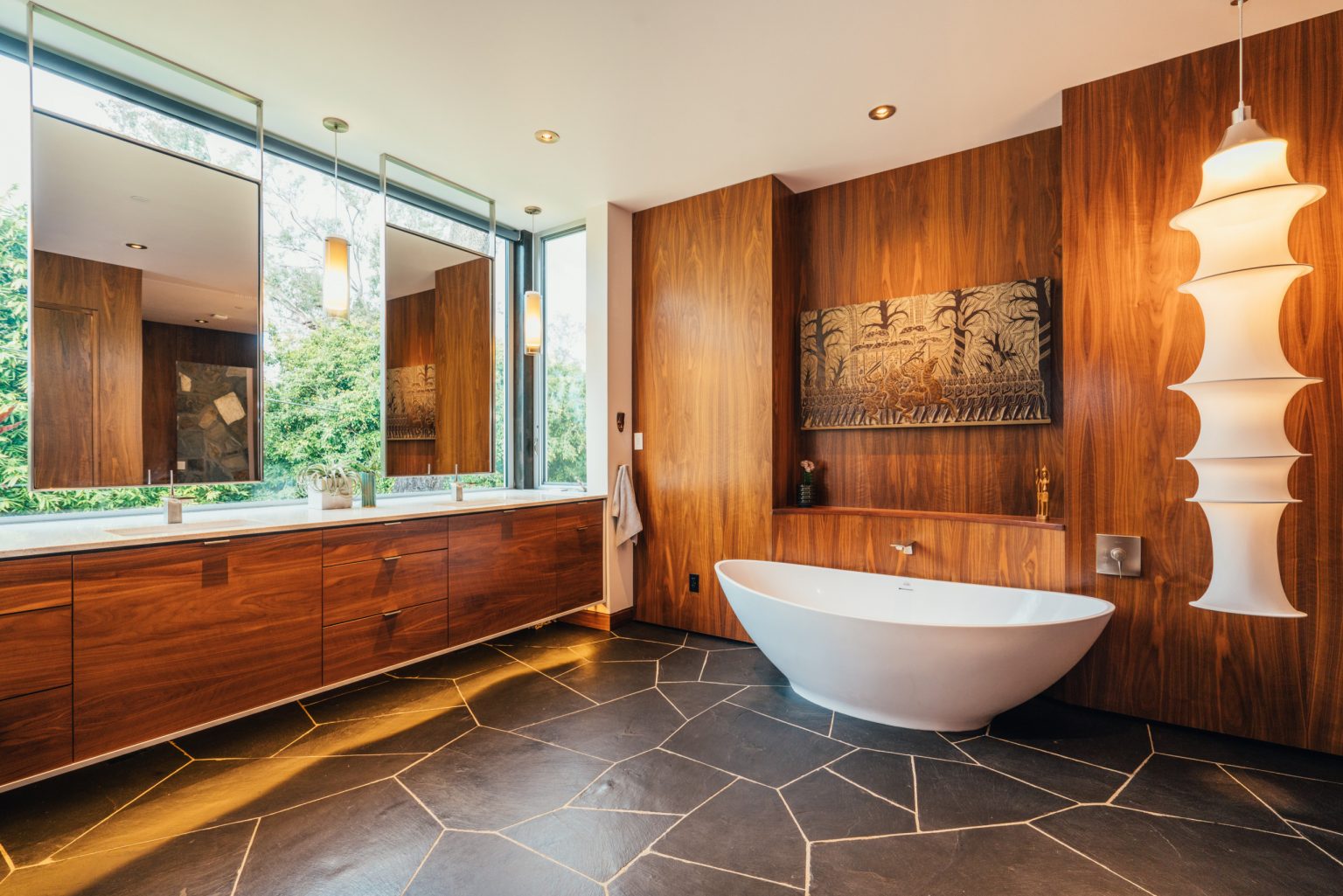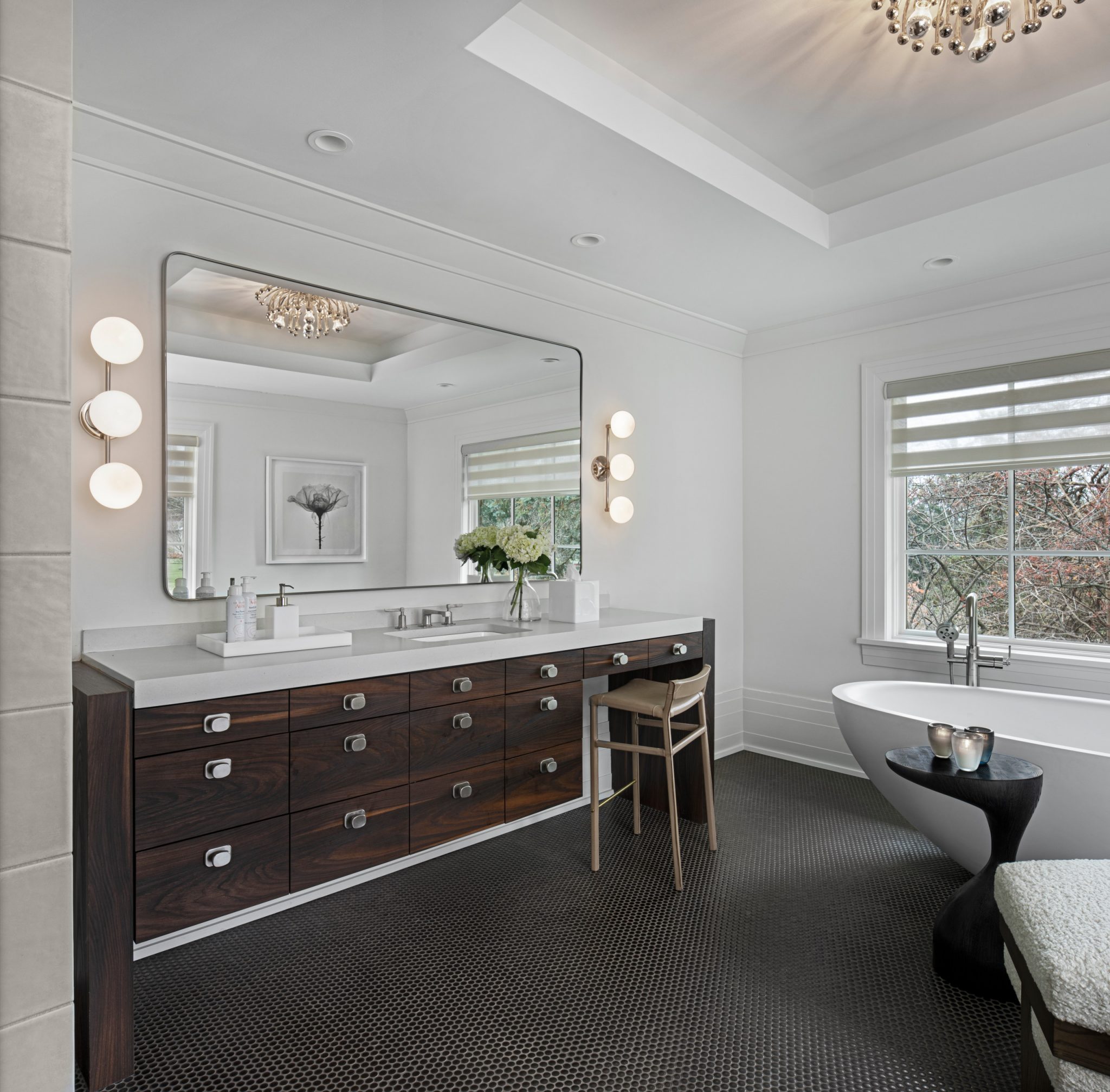Defining Mid-Century Modern Bathroom Style: Mid Century Modern Bathrooms Images

The mid-century modern bathroom style, often referred to as MCM, is a timeless and elegant design aesthetic that emerged in the mid-20th century. It is characterized by clean lines, simple forms, and a focus on functionality. This style seamlessly blends modern elements with a touch of retro charm, creating a sophisticated and inviting atmosphere.
Key Characteristics of Mid-Century Modern Bathroom Design, Mid century modern bathrooms images
The mid-century modern bathroom style is defined by its distinctive features, which are reflected in the color palettes, materials, and fixtures used.
- Color Palettes: Mid-century modern bathrooms often feature a muted and earthy color palette. Neutral tones like beige, gray, and brown are commonly used, creating a sense of tranquility and sophistication. These colors are often complemented by pops of vibrant hues like turquoise, mustard yellow, and burnt orange, adding a touch of personality and warmth to the space.
- Materials: Natural materials play a significant role in mid-century modern bathroom design. Wood, stone, and ceramic are frequently used for flooring, countertops, and vanities, bringing a sense of warmth and authenticity to the space. Metals like brass, chrome, and copper are often incorporated into fixtures and accents, adding a touch of elegance and sophistication.
- Fixtures: Mid-century modern bathrooms feature distinctive fixtures that reflect the era’s emphasis on simplicity and functionality. Sleek and streamlined faucets, often with a single lever, are common. Curved or geometric shapes are often seen in mirrors, towel bars, and other accessories, adding a touch of sophistication and style.
Historical Context and Influences
The mid-century modern bathroom style emerged in the mid-20th century, influenced by the design principles of the time. The movement was characterized by a rejection of traditional ornamentation and a focus on functionality and simplicity.
- Architects and Designers: Key figures in the mid-century modern movement, such as architects Frank Lloyd Wright, Mies van der Rohe, and designers Eero Saarinen, played a significant role in shaping the aesthetic. Their designs emphasized clean lines, open spaces, and the use of natural materials, which had a profound influence on bathroom design.
- Post-World War II Era: The post-World War II era saw a surge in suburban development and a growing demand for affordable and functional housing. This led to the emergence of new design principles that emphasized simplicity and affordability, which were reflected in the mid-century modern bathroom style.
- Influence of Scandinavian Design: Scandinavian design, with its emphasis on functionality, minimalism, and natural materials, also had a significant influence on the mid-century modern aesthetic.
Iconic Mid-Century Modern Bathrooms
Several iconic bathrooms embody the essence of the mid-century modern style.
- The Eames House Bathroom: The bathroom in the Eames House, designed by Charles and Ray Eames, is a classic example of mid-century modern design. It features a simple, open layout, natural materials, and a muted color palette. The minimalist design emphasizes functionality and creates a serene and inviting atmosphere.
- The Case Study House #22 Bathroom: The bathroom in Case Study House #22, designed by architect Pierre Koenig, showcases the use of glass and steel in mid-century modern design. The large windows offer stunning views of the surrounding landscape, blurring the lines between indoor and outdoor spaces. The minimalist design and use of natural materials create a sense of openness and tranquility.
- The Fallingwater Bathroom: The bathroom in Frank Lloyd Wright’s iconic Fallingwater house is a testament to the architect’s innovative use of natural materials and his integration of architecture with the surrounding landscape. The bathroom features a large window overlooking a waterfall, creating a breathtaking and immersive experience. The use of stone and wood adds a sense of warmth and authenticity to the space.
Essential Elements of a Mid-Century Modern Bathroom
The mid-century modern bathroom style is a timeless design aesthetic that seamlessly blends functionality and elegance. It’s a style that embraces clean lines, natural materials, and a focus on creating a serene and inviting space. To achieve this coveted look, there are several key elements that play a crucial role in shaping the overall design.
Color Palette
Mid-century modern bathrooms often feature a harmonious color palette that emphasizes natural tones and muted hues. The use of earthy colors like beige, brown, and green creates a sense of tranquility and connection to nature. These colors can be further enhanced with pops of brighter colors like yellow, blue, or orange, adding a touch of vibrancy and personality. For example, a beige bathroom with a vibrant blue shower curtain or a green vanity would create a stunning contrast.
Materials
Mid-century modern bathrooms are known for their use of natural materials. Wood, stone, and tile are frequently incorporated to bring warmth and texture to the space. Wood is often used for vanities, cabinets, and shelves, while stone and tile are commonly used for flooring and countertops. These materials are durable and add a touch of sophistication to the bathroom. However, synthetic materials like laminates and acrylic are also used in mid-century modern bathrooms. Laminates offer a cost-effective alternative to wood, while acrylic is known for its durability and ease of maintenance.
Fixtures
Mid-century modern bathroom fixtures are characterized by their simple and elegant design. Faucets often feature sleek, minimalist lines and are typically made of chrome or brushed nickel. Sinks often have a geometric or oval shape and are made of ceramic, porcelain, or stone. Toilets are typically elongated and feature a sleek, modern design. Showers are often walk-in with a minimalist showerhead.
Lighting
Lighting plays a crucial role in creating the desired atmosphere in a mid-century modern bathroom. Natural light is often maximized by using large windows or skylights. Artificial lighting is used to complement natural light and create a warm and inviting ambiance. Recessed lighting is often used in the ceiling, while pendant lights or sconces can be used to illuminate specific areas, such as the vanity or bathtub.
Storage Solutions
Mid-century modern bathrooms often feature a variety of storage solutions that are both functional and stylish. Cabinets, shelves, and vanities are commonly used to store toiletries and other bathroom essentials. Cabinets can be built-in or freestanding and are often made of wood or laminate. Shelves can be open or enclosed and are often made of wood or metal. Vanities can be simple or elaborate and often feature a built-in sink and storage space.
Inspiration and Ideas for Mid-Century Modern Bathrooms

Transforming your bathroom into a mid-century modern sanctuary requires a blend of functionality and style. This design aesthetic, characterized by clean lines, geometric shapes, and a focus on natural materials, offers a timeless appeal. Explore the following ideas to inspire your mid-century modern bathroom design.
Layout and Space Planning
Mid-century modern bathrooms prioritize functionality and efficient use of space. Open layouts, with minimal partitions, create a sense of spaciousness. This approach emphasizes a streamlined and uncluttered aesthetic.
- Open Shower Design: Consider an open shower area, eliminating the need for a traditional shower enclosure. This creates a seamless transition between the shower and the rest of the bathroom, enhancing the feeling of openness.
- Floating Vanities: Floating vanities, suspended from the wall, minimize visual clutter and create a sense of airiness. They also provide valuable floor space for easy cleaning.
- Multifunctional Storage: Incorporate built-in storage solutions, such as cabinets or shelves, to maximize space efficiency. This allows for discreet storage while maintaining a clean and uncluttered look.
Color Combinations and Patterns
Mid-century modern bathrooms often feature a harmonious palette of colors and patterns. Neutral tones like white, gray, and beige provide a backdrop for bold pops of color. Geometric patterns and textures add visual interest.
- Monochromatic Palette: A monochromatic palette, using various shades of a single color, creates a sense of calm and sophistication. For example, a bathroom with white walls, gray tiles, and black accents would offer a refined and timeless aesthetic.
- Bold Accent Colors: Introduce pops of color with vibrant towels, rugs, or artwork. Mustard yellow, teal blue, and burnt orange are popular mid-century modern color choices.
- Geometric Patterns: Incorporate geometric patterns in tiles, wallpaper, or textiles. Think chevron, diamond, or herringbone patterns for a visually stimulating and dynamic space.
Materials and Finishes
Mid-century modern bathrooms embrace natural materials and finishes. Wood, stone, and metal are commonly used to create a warm and inviting atmosphere.
- Wood Accents: Introduce wood elements in the vanity, shelving, or even the flooring. Walnut, teak, and mahogany are popular choices for their rich color and natural grain.
- Stone Tiles: Stone tiles, such as marble, granite, or slate, offer a timeless and elegant touch. They can be used for flooring, walls, or countertops.
- Metal Finishes: Brass, chrome, or nickel finishes add a touch of sophistication to bathroom fixtures and accessories. Consider brushed finishes for a more understated look.
Fixtures and Accessories
Mid-century modern bathroom fixtures and accessories are characterized by clean lines and simple forms. They often feature unique details and materials.
- Freestanding Tubs: A freestanding tub, placed in a prominent position, adds a touch of luxury and elegance. Look for tubs with clean lines and minimal embellishments.
- Geometric Mirrors: Geometric mirrors, with round, square, or rectangular shapes, complement the mid-century modern aesthetic. They can be framed in wood, metal, or even left unframed for a minimalist look.
- Statement Lighting: Choose lighting fixtures with unique shapes and materials. Consider pendant lights, sconces, or even a statement chandelier to add visual interest.
Lighting and Decor
Lighting plays a crucial role in creating the desired atmosphere in a mid-century modern bathroom. Natural light is always preferred, but consider using artificial lighting to enhance the space.
- Natural Light: Maximize natural light by incorporating large windows or skylights. This creates a bright and airy feel, highlighting the clean lines and materials.
- Layered Lighting: Use a combination of ambient, task, and accent lighting to create a balanced and functional space. Ambient lighting provides general illumination, task lighting focuses on specific areas, and accent lighting highlights specific features.
- Decorative Touches: Add decorative elements to personalize your bathroom. Mid-century modern artwork, vintage accessories, or plants can enhance the overall aesthetic.
